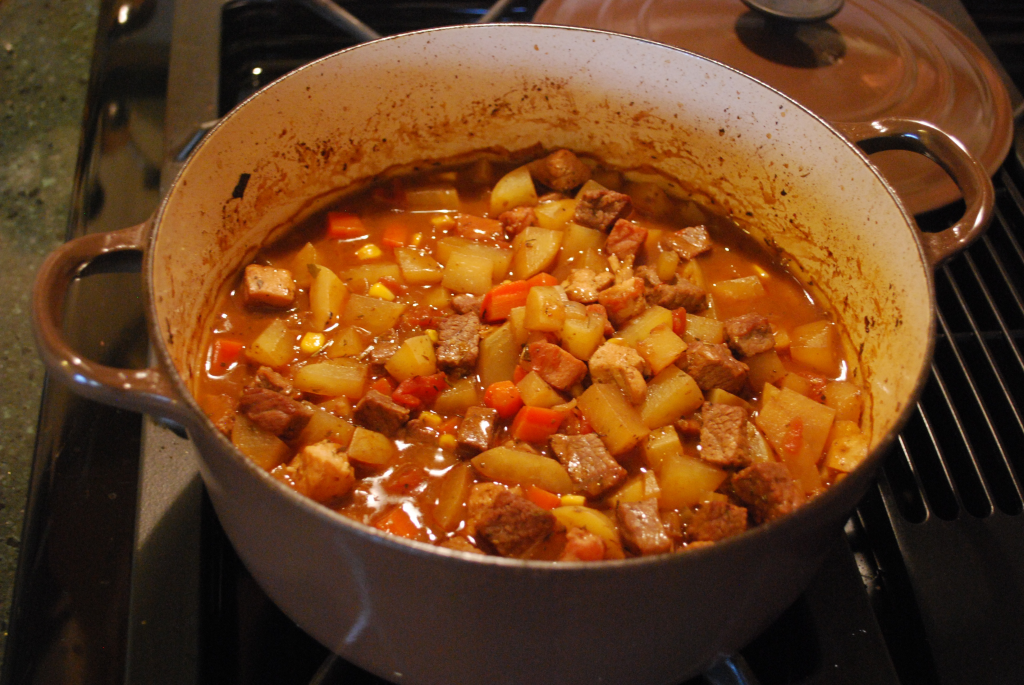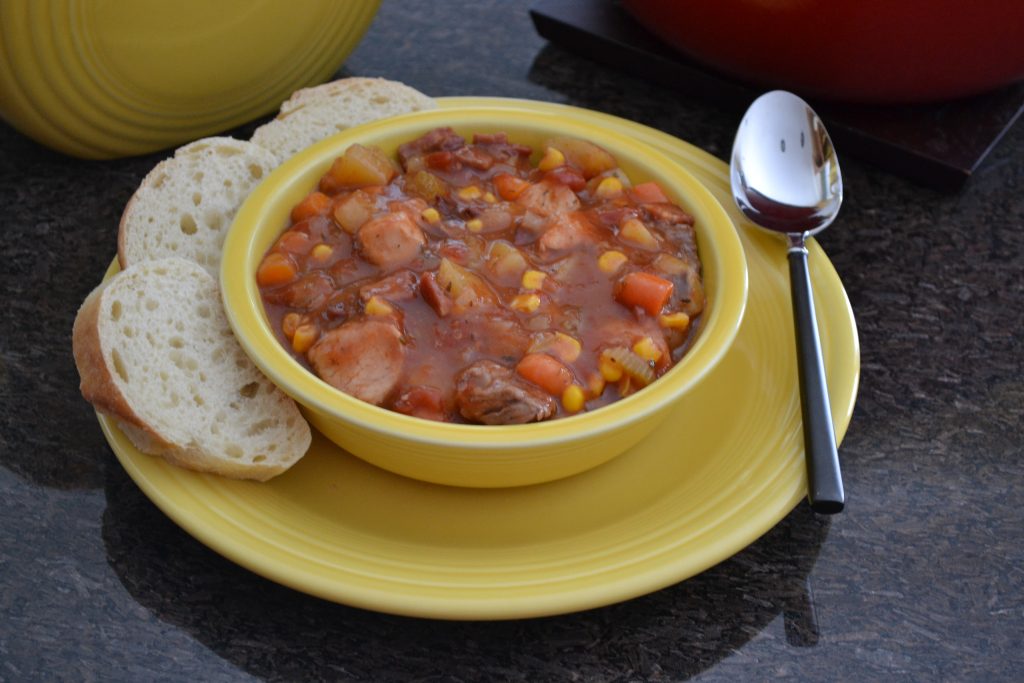Legend has it that one of Kentucky’s most beloved dishes was created by a Confederate Army chef with little more than two dozen blackbirds, a few crows, some old hens and a sparse assortment of vegetables, while surrounded by an armed brigade of hungry soldiers who hadn’t seen a good meal in a long time. The resourceful chef, Gus Jaubert, turned the ingredients into a bird stew, every last drop of which was promptly, and appreciatively, devoured. When asked what he called his creation, Chef Jaubert replied, “bird stew,” but due to his speech impediment the men thought he said “burgoo,” and the name stuck.

It’s a cleverly spun tale, and yes probably also complete fiction. Burgoo’s roots stretch back well before the Civil War. In the early 1800s it was commonly spelled burgout, perhaps a modification of the French ragout, which is a thick stew of meat, poultry, or fish, often containing vegetables. Burgoo (pronounced bur-GOO or BURG-oo) is a soup or stew made from a combination of meats, vegetables and seasonings; a vague definition illustrating that it is not so much a recipe as a perpetual work-in-progress.
It is a dish little known outside the Bluegrass State, although residents of other parts of the country might recognize a kinship with the South’s Brunswick Stew and the upper Midwest’s booya. While all three can rather blandly be described as “hunter’s stew,” the term does not do justice to the rich heritage of preparation that all three possess. They have been social meals and community events for generations. It’s equipment and recipes handed down after a lifetime of apprenticeship. Friends and neighbors contribute ingredients, labor, and time to stir the pot, then gather together to share a meal.
Neighborly cordiality aside, it is usually conceded by those involved that the most important ingredient of a burgoo is a strong antipathy to everyone else’s version. This is closely followed by a conviction that one’s recipe is under relentless threat of espionage and theft by the aforementioned cordial neighbors. Spices, their quantities, and order of incorporation into the pot have been handed down during deathbed vigils, the burgoo master unwilling to part with his secret formula while there remained even the slightest chance of recovery in time for the next burgoo cook-off.
As for technique, a proper burgoo should be cooked until thick enough to hold the stirring spoon upright. It is traditionally cooked in a large cauldron or kettle outdoors over a wood fire for at least 12 hours. And although bourbon is often mentioned as an ingredient, it is not for the stew pot, but solely for the cook’s enjoyment.
Early versions of the dish used whatever was available, from livestock to wild game. Venison, pheasant, quail and wild turkey were commonly used, and especially squirrel. In the nineteenth century, migration patterns brought a flood of squirrels into Kentucky. John James Audubon recorded an 1819 trip down the Ohio River in which he witnessed thousands of squirrels swimming across the river into the state. Stores ran out of shot as residents tried to stem the tide. Hunters were dispatched to protect crops and forests, and the results led to community-wide burgoo dinners featuring squirrel. In fact, squirrel meat was so prevalent as a food source that people developed a preference either for the nut-flavored meat of a forest-based squirrel, or the sweeter meat of an orchard-based squirrel. It’s a debate reminiscent of the ongoing one today over corn-fed versus grass-fed cattle.
Given modern day legal restrictions on the commercial sale of wild game for consumption, today’s versions of burgoo use chicken, beef, mutton and pork. In and around Owensboro in western Kentucky—the heart of the burgoo world—mutton is king. Connoisseurs believe using mutton as the predominant meat makes up for the complexity and earthiness of flavor absent when wild game is not used. Where mutton is omitted, smoked meats are a good substitute. Others simply add hot sauce or beer.

Burgoo has always featured a farmer’s market of vegetables, from the standards like tomatoes, potatoes and onions, to the semi-unusual cabbage, and the downright unpopular lima beans and okra. Cooks should beware that the innocuous lima bean has frightened away many potential burgoo devotees, although probably fewer than if squirrel returned to the ingredient list.
Fortunately for the cook, burgoo is best prepared in mass quantities so there is usually someone available to help stir the pot and share the blame if necessary. “Burgoo King” James T. Looney of Lexington, Kentucky once served 5,000 people with a recipe that called for more than 1,000 pounds of meat and poultry, 60 gallons of canned tomatoes, 200 pounds of cabbage and 15 bushels of potatoes. At a smaller gathering serving only 900 gallons, the host was so impressed with Mr. Looney’s burgoo that he named one of his thoroughbreds Burgoo King. Burgoo King went on to win the Kentucky Derby in 1932, and perhaps it was in honor of such a fine name that Burgoo King was the first Derby winner to wear the now-famous blanket of roses in the Winner’s Circle.
« Previous Post



Leave a Comment
No Responses to “Kentucky’s Other Secret Recipe by Kathleen Gibson”